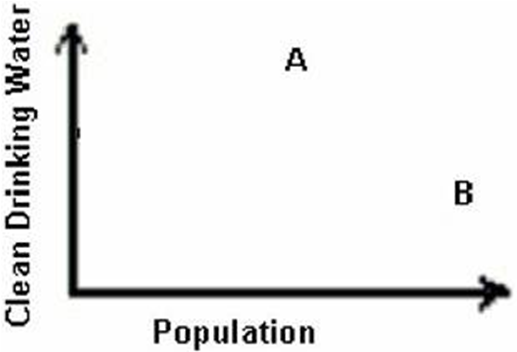A) Antibiotics.
B) Hormones.
C) Dissolved Metals.
D) Insecticides.
E) Antidepressants.
G) D) and E)
Correct Answer

verified
Correct Answer
verified
Multiple Choice
In general, water use in poor countries is dominated by
A) agricultural use.
B) domestic needs.
C) industrial activities.
D) use as drinking water.
E) All of these are correct.
G) A) and B)
Correct Answer

verified
Correct Answer
verified
Multiple Choice
Principal problems that have resulted from the construction of large dams include
A) evaporation and siltation.
B) leakage and weakening of bedrock.
C) mercury poisoning.
D) the relocation of people.
E) All of these are correct.
G) B) and E)
Correct Answer

verified
Correct Answer
verified
Multiple Choice
Most water in the atmosphere has evaporated from the ocean, and ______ rain falls back into the sea. About ________ % of the earth's total rain falls on land.
A) most; 10
B) most; 20
C) less; 55
D) less; 70
E) None of these. Most water in the atmosphere does not evaporate from the sea.
G) A) and C)
Correct Answer

verified
Correct Answer
verified
Multiple Choice
Tertiary treatment of sewage produces water that is usable for
A) agriculture.
B) drinking.
C) industrial activities.
D) watering livestock.
E) dumping into freshwater systems.
G) C) and D)
Correct Answer

verified
Correct Answer
verified
Multiple Choice
The place where aquifers are most likely to be contaminated is at
A) artesian springs.
B) seeps and other outlets.
C) recharge zones.
D) all discharge and recharge areas.
E) the zone of aeration.
G) A) and B)
Correct Answer

verified
Correct Answer
verified
Multiple Choice
Many cities in the American Southwest rely on sources of drinking water that contaminated with __________________.
A) arsenic
B) lead
C) coliform bacteria
D) DDT
E) none of these are correct.
G) C) and E)
Correct Answer

verified
A
Correct Answer
verified
True/False
Domestic water conservation in the United States would save about 20% of the water we now use. Therefore, we need to come up with better technology to avoid strict restrictions in the future.
B) False
Correct Answer

verified
Correct Answer
verified
Multiple Choice
Plants that take up heavy metals found in water would be an example of
A) containment of pollutants.
B) tertiary sewage treatment.
C) bioremediation.
D) wetland treatment.
E) in vitro extraction techniques.
G) A) and C)
Correct Answer

verified
C
Correct Answer
verified
Multiple Choice
The city of Arcata, California, is notable because it designed a _________ to treat its sewage.
A) system of modern outhouses
B) fully modern, technologically advanced system
C) natural marsh
D) corporate sponsorship system
E) living machine
G) B) and D)
Correct Answer

verified
Correct Answer
verified
Multiple Choice
Best available economically achievable technology (BAT) standards are standards set for
A) nonpoint pollution.
B) toxic substances.
C) radioactive waste, specifically.
D) organic compounds.
E) all point sources.
G) B) and C)
Correct Answer

verified
Correct Answer
verified
Multiple Choice
The activity that uses the greatest share of U.S. household water is
A) bathing.
B) drinking and cooking.
C) flushing the toilet.
D) washing clothes and dishes.
E) watering lawns.
G) B) and E)
Correct Answer

verified
Correct Answer
verified
True/False
The National Pollution Discharge Elimination System (NPDES) was established as a part of the Resource Conservation and Recovery Act (RCRA).
B) False
Correct Answer

verified
Correct Answer
verified
Multiple Choice
Use the following graph for the question.
 -On the graph of clean drinking water per person, each letter represents a country. Which of the following is most likely?
-On the graph of clean drinking water per person, each letter represents a country. Which of the following is most likely?
A) A is the United States; B is India.
B) B is the United States; A is India.
C) A is the United States; B is Canada.
D) B is India; A is China.
E) A is India; B is China
G) D) and E)
Correct Answer

verified
Correct Answer
verified
Multiple Choice
A method of increasing water supplies that has been successful, if expensive, is
A) desalination by reverse osmosis.
B) cloud seeding.
C) towing icebergs by ship from polar regions.
D) altering the climate's convection currents.
E) None of these methods are successful.
G) A) and E)
Correct Answer

verified
Correct Answer
verified
Multiple Choice
Coliform bacteria populations are routinely monitored in drinking water supplies, swimming pools, and at beaches because these bacteria
A) are especially toxic to animals.
B) may mutate into severely pathogenic strains.
C) indicate the presence of feces in water.
D) usually live in pesticide-contaminated water.
E) are more difficult to find in water.
G) A) and D)
Correct Answer

verified
Correct Answer
verified
Multiple Choice
Which of the following factors is the most important factor in determining whether a country is "water rich" or "water poor"?
A) population density
B) country size
C) humid climate
D) rivers running through the country
E) renewable water supplies
G) None of the above
Correct Answer

verified
Correct Answer
verified
Multiple Choice
Withdrawal is the total amount of water
A) lost in transmission, due to evaporation or leakage.
B) taken from rivers, lakes, or aquifers.
C) used in manufacturing or agriculture.
D) altered or polluted in human activities.
E) lost due to chemical transformation because of human use.
G) D) and E)
Correct Answer

verified
Correct Answer
verified
Multiple Choice
The total amount of water on the Earth ____________ from year to year and the hydrologic cycle ________________.
A) stays about the same; moves it from one place to another place
B) increases; captures it from the incoming solar radiation
C) increases; gains water from the Earth's interior
D) decreases; moves it from one place to another place
E) decreases; loses water to the atmosphere
G) B) and C)
Correct Answer

verified
A
Correct Answer
verified
True/False
An oligotrophic lake would be very productive.
B) False
Correct Answer

verified
Correct Answer
verified
Showing 1 - 20 of 30
Related Exams